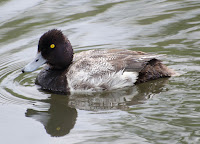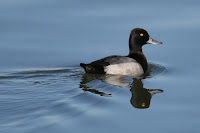LESSER SCAUP
LESSER SCAUP (Aythya affinis) – (See images below)
DESCRIPTION: The Lesser Scaup is a North American small diving duck, measuring some 45 cm (18 in.) long. The breeding male (drake) has a slightly iridescent black head, a black neck and breast, and rump. The back and wings are finely striated black on white, and the sides and belly are white. The eyes are yellow and the bill is light grey, with a tiny black tip. Females are brown overall, with a darker head and a white patch at the base of the bill, which is black. The wings are brown with a white band on the secondaries. Non-breeding males are brown overall, with the back and sides finely striated on light grey.
VOICE: https://www.xeno-canto.org/species/Aythya-affinis
NAME: The English name ‘Lesser’ implies that there is a ‘Greater’ Scaup. The name ‘Scaup’ would origin from Sottish ‘scalp’ and refers to a ledge in the water, where these ducks gather to feed. Another explanation would be that it is an onomatopoeia for one of the female’s calls. The Latin genus name ‘Aythya’ comes from Greek and refers to a ‘kind of waterbird’, and the species name ‘affinis’ means ‘related’, in reference to its similarity to the greater scaup.
HABITAT: The habitat of the lesser scaup includes wetlands such as marshes, ponds, small lakes, reservoirs, and coastal bays in the winter.
DIET: They forage on the bottom in the mud for molluscs (including the invasive Zebra mussel), small crustaceans, plant material such as seeds, and insects and their larvae.
NESTING: Lesser scaups build their nests in a sheltered area among thick vegetation near water, or on floating vegetation.
DISTRIBUTION: Lesser scaups are very abundant ducks. Their main breeding range encompasses the Prairie Pothole Region and the Canadian boreal forest up to the tundra. They migrate to the southern half of the USA for the winter, and also to Mexico, the Caribbean and Central America. There are also regular winter visitors to Hawaii.
DISTRIBUTION MAP: https://en.wikipedia.org/wiki/Lesser_scaup#/media/File:Aythya_affinis_map.svg
ON PEI: The lesser scaup does not breed on Prince Edward Island. Its occurrence on the island varies according to the seasons and the years, from uncommon to occasional to rare. In addition, it is a duck species with an ‘irruptive’ behavior. A few sightings at various locations have been reported in the fall of 2005, during migration.
CONSERVATION: the population of the lesser scaup has declined steadily over the last few decades, but the species is still listed as of ‘least concern’ due to its high numbers. Some potential threats include habitat degradation and loss due to oil spills or other form of pollution, resource extraction, and hunting (although legally hunted, the number of catches is limited.)
NOTES: These are social birds that congregate with other duck species. Sometimes flocks on the water are so dense as to form a floating ‘mat’.
SIMILAR SPECIES: Greater Scaup, Ring-necked Duck, Tufted Duck
(here’s an article to help distinguish the Lesser from the Greater Scaup)
REFERENCES: https://en.wikipedia.org/wiki/Lesser_scaup
https://www.allaboutbirds.org/guide/Lesser_Scaup/id
https://www.audubon.org/field-guide/bird/lesser-scaup
https://www.ducks.ca/species/lesser-scaup/
http://www.birdweb.org/birdweb/bird/lesser_scaup
DESCRIPTION: The Lesser Scaup is a North American small diving duck, measuring some 45 cm (18 in.) long. The breeding male (drake) has a slightly iridescent black head, a black neck and breast, and rump. The back and wings are finely striated black on white, and the sides and belly are white. The eyes are yellow and the bill is light grey, with a tiny black tip. Females are brown overall, with a darker head and a white patch at the base of the bill, which is black. The wings are brown with a white band on the secondaries. Non-breeding males are brown overall, with the back and sides finely striated on light grey.
VOICE: https://www.xeno-canto.org/species/Aythya-affinis
NAME: The English name ‘Lesser’ implies that there is a ‘Greater’ Scaup. The name ‘Scaup’ would origin from Sottish ‘scalp’ and refers to a ledge in the water, where these ducks gather to feed. Another explanation would be that it is an onomatopoeia for one of the female’s calls. The Latin genus name ‘Aythya’ comes from Greek and refers to a ‘kind of waterbird’, and the species name ‘affinis’ means ‘related’, in reference to its similarity to the greater scaup.
HABITAT: The habitat of the lesser scaup includes wetlands such as marshes, ponds, small lakes, reservoirs, and coastal bays in the winter.
DIET: They forage on the bottom in the mud for molluscs (including the invasive Zebra mussel), small crustaceans, plant material such as seeds, and insects and their larvae.
NESTING: Lesser scaups build their nests in a sheltered area among thick vegetation near water, or on floating vegetation.
DISTRIBUTION: Lesser scaups are very abundant ducks. Their main breeding range encompasses the Prairie Pothole Region and the Canadian boreal forest up to the tundra. They migrate to the southern half of the USA for the winter, and also to Mexico, the Caribbean and Central America. There are also regular winter visitors to Hawaii.
DISTRIBUTION MAP: https://en.wikipedia.org/wiki/Lesser_scaup#/media/File:Aythya_affinis_map.svg
ON PEI: The lesser scaup does not breed on Prince Edward Island. Its occurrence on the island varies according to the seasons and the years, from uncommon to occasional to rare. In addition, it is a duck species with an ‘irruptive’ behavior. A few sightings at various locations have been reported in the fall of 2005, during migration.
CONSERVATION: the population of the lesser scaup has declined steadily over the last few decades, but the species is still listed as of ‘least concern’ due to its high numbers. Some potential threats include habitat degradation and loss due to oil spills or other form of pollution, resource extraction, and hunting (although legally hunted, the number of catches is limited.)
NOTES: These are social birds that congregate with other duck species. Sometimes flocks on the water are so dense as to form a floating ‘mat’.
SIMILAR SPECIES: Greater Scaup, Ring-necked Duck, Tufted Duck
(here’s an article to help distinguish the Lesser from the Greater Scaup)
REFERENCES: https://en.wikipedia.org/wiki/Lesser_scaup
https://www.allaboutbirds.org/guide/Lesser_Scaup/id
https://www.audubon.org/field-guide/bird/lesser-scaup
https://www.ducks.ca/species/lesser-scaup/
http://www.birdweb.org/birdweb/bird/lesser_scaup
 |
| Lesser scaup male, AB - by Connor Mah |
 |
| Lesser scaup female, photo by Basar |
 |
| Lesser scaup drake in alternate plumage Alexandria, VA, by sherseydc |
 |
| Lesser scaup drake with two females Calif., by Alan Schmierer, Dec. 2006 |